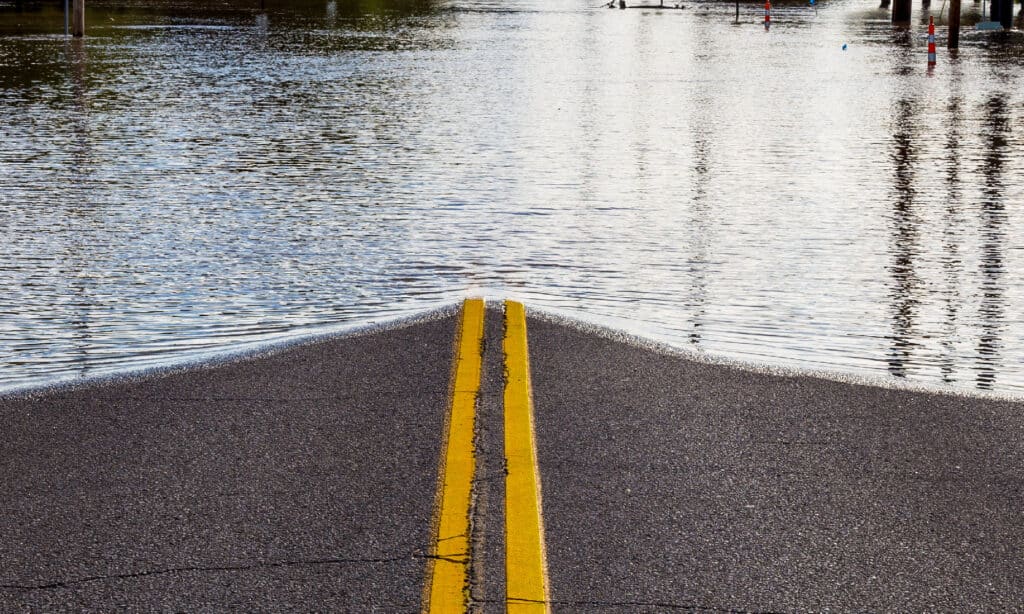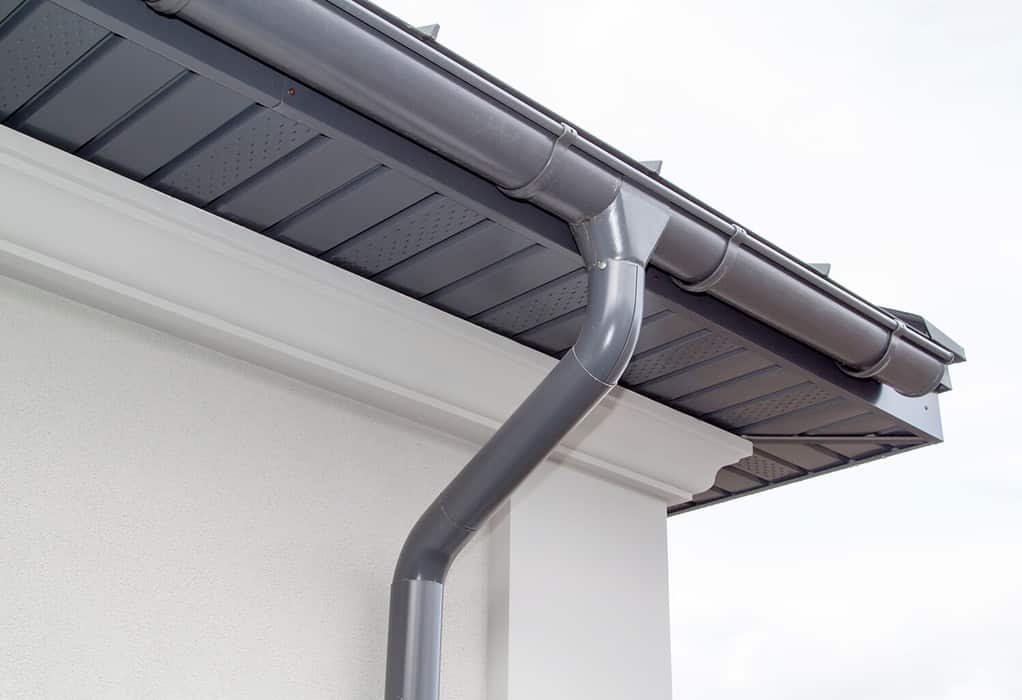If your home suffers from soddy grassy, deep puddles, and water seeping into the basement, you may need an irrigation or drainage solution. There’s a good chance your yard doesn’t drain properly — or at least, to where it’s supposed to.
A long-lasting and attractive-looking fix to yard drainage problems is a French drain. These drains, which homeowners can install themselves, collect and redirect surface and groundwater from one area into another.
Keep reading to learn more about French drains — including their primary purpose, origins, and a step-by-step guide to installing one yourself.
What Is a French Drain?
According to Mark Morris, an independent master plumber with over 10 years of experience in plumbing and HVAC — who is the current consultant for Deluxe Plumbers in Texas — a French drain is “basically a rock-filled ditch.”

You need to dig a trench to install a French drain.
©MARHARYTA MARKO/iStock via Getty Images
He went on to explain in layman’s terms that “French drains are an effective way to manage water runoff and drainage issues on a property. [They have] a perforated pipe that diverts surface water and groundwater away from the area — like the foundation of your home. The road runs downhill from the problem area, so the water, by gravity, flows to a more convenient location outside a storm drain or catch basin. It collects, then moves away from the area you don’t want.”
Hundreds of years ago in the nineteenth century, Europe invented the first French drains. However, they’re not named for the country of France, but rather the lawyer who popularized them in America.
Henry French was the Assistant U.S. Treasury Secretary from 1876 until his death in 1885, and a lawyer who lived in Concord, Massachusetts. While his background seemed legal-focused, French remained a well-researched and read agricultural writer throughout his life, writing and publishing hundreds of works in different agricultural journals of the time.
In his widely-read pamphlet titled Farm Drainage: The Principles, Processes, and Effects of Draining Lains, French described the use and build of these drains in detail, leading to more and more people adopting the efficient irrigation and drainage system.
What Is the Purpose of a French Drain?
At its base, a French drain’s purpose is to prevent both groundwater and surface water from damaging buildings (like homes and businesses). However, the secondary use of a French drain is to remove pooling water from gardens that are prone to have puddles of standing water.
For homes and gardens with Type C soil, as outlined by Murray State University’s Environmental Safety Department, take care of excavation. Type C soil is notoriously unstable and easily saturated. Saturated soil remains one of the top causes of soggy land, sagging lawns, and frequent flooding.
How to Install a French Drain
Any homeowner or handyman who has a basic understanding of excavation and installation can install a French drain themselves. According to Morris, “Homeowners can install French drain plumbing themselves. You’ll need tools like shovels and levels, as well as items like gravel and perforated drain pipe, which are usually made of PVC.”
“However,” Morris cautions, “in complex cases involving drains, or if the drains must be particularly long or deep, a professional should be consulted.”

French drains specifically prevent flooding water from reaching a home and redirect it somewhere more suitable.
©iStock.com/KSwinicki
Quinten O’Dea is a professional landscaper with over 13 years of experience with Q&A Landscaping, which installs several French drains every year and has it down to a science. “A homeowner could complete a French drain on their own if the soil is reasonable to dig through, or they consider renting a machine like a trencher or mini excavator if the site access allows it.”
What Tools Do You Need to Install a French Drain?
For even the most rudimentary outdoor French drain, you’ll need to obtain the following tools and materials:
- A trencher or a shovel (to dig the trench).
- Topsoil.
- Sand.
- Landscaping fabric (for lining the trench’s path).
- A perforated drain pipe (most common: four-inch perforated pipe).
- Gravel and/or landscaping stones.
- Turf grass.
Step-by-Step Process of Installing a French Drain
Building a French drain for your yard is a multi-day undertaking. However, its steps are fairly straightforward.
- Mark the area you will excavate. During your initial planning phase, you should know where your French drain will start and end.
- Dig the trench. Using a pick ax, trencher, excavation tool, or shovel, create the trench for your drain. Don’t exceed the nearest foundation for the depth of your trench to encourage the natural flow of water.
- Put landscaping fabric and gravel down. After you have a clear, clean trench dug out, put both the fabric and gravel along the length of the trench. Gravel should be at least three inches thick.
- Insert the pipe and cover it with gravel. Ensure you measure the right length, and then place your drain pipe in the prepared trench. Once you’re happy with the placement, cover it with gravel.
- Fold over excess landscaping fabric. If you left extra fabric on the sides of the trench, fold it over the gravel-covered drain pipe for extra protection.
- Cover and landscape. Using the turf grass you purchased, cover the landscaping fabric with it to give your trench a completely hidden look. Be careful not to weigh down the drain pipe too much with lawn ornaments or heavy machinery, or you risk cutting into the drain pipe’s flow.
Now, all that’s left to do is monitor the French drain for clogs — especially after heavy rains, snows, or storms. The only parts of the French drain that need to stay open are the opening, where the water first comes from, and the end, where the water drains out.
If part of your French drain becomes damaged and begins leaking into your yard, avoid the temptation of only replacing a portion. Instead, replace the entire French drain.
Key Considerations for French Drain Installation
If you follow the steps carefully enough, you’ll be able to install your French drain with minimal issues and maximum efficiency. Still, the experts interviewed by A-Z Animals had more tips for homeowners attempting to install French drains on their own.
For O’Dea, the most important reminder came down to the excess that trench digging will yield. “There will be a good bit of dirt to remove, so it is important to have a place in mind to use the dirt on site to keep things easy.”
O’Dea reminded DIYers to think about what happens after drain installation, too. “The dirt will be replaced with clean 2b limestone or river gravel, which will also need to be considered when attempting to DIY this project. Don’t forget the last step, which is fixing the grass upon completion with seed and straw.”
Expert Reminders for French Drain Installation
Morris, on the other hand, gave A-Z Animals a handy list of reminders and key considerations when installing a French drain. They include:
- Plan the layout. Knowing where the water will enter and exit is crucial.
- Measure depth and width correctly. A typical French drain trench is about 18 to 24 inches deep and 6 to 12 inches wide, but this can vary depending on your specific needs.
- Lay the gravel base. Always lay down an initial layer of gravel before placing your pipe.
- Place your pipes well. The holes in the pipe should face down to prevent silt from clogging the pipe.
- Test it. Before covering everything up, it’s a good idea to test the drain with water to ensure it’s working properly.
If you’re new to home improvement projects, don’t be afraid to call in a professional. French drains can be tricky when it comes to excavation, and you want to ensure you’re making your drainage problem better with the installation of a French drain — not worse.
Other Lawn Irrigation Techniques
If you don’t like the look of a French drain, or your yard isn’t conducive to the construction it would take to install, you have a few other options.

Drain pipes and gutters are a nice alternative to French drains.
©sommthink/Shutterstock.com
Channel Drains
The best use of a channel drain is to prevent puddles from forming around outdoor pools, water from flowing into a basement or garage, and puddles from forming on walkways and sidewalks. You’ve probably seen channel drains at businesses, schools, and hospitals: they look like a strip of pavement has been taken away, and a grate placed over top of it.
On each side of a channel drain, a pipe redirects the water flow that’s collected to the appropriate draining system. More often than not, channel drains are a small portion of a larger drainage system.
Dry Wells
While not technically a drain, dry wells are a type of water collection apparatus that can be used in conjunction with French drains, swale drains, and channel drains to take water from close to your home to the appropriate drainage system.
Most dry wells, situated underground, can hold around 50 gallons of collected water. It features small holes which let water seep out slowly over time.
Yard Drains
Similar to dry wells, yard drains function as a catchall for surface water and redirect it to the proper drainage system. Unlike dry wells, however, yard drains don’t allow water to escape. Instead, it’s a mini sewer system that completely redirects the water caught in the basin to the right place. As such, it can handle much more water at a time than dry wells can.
Swale Drains
While some like to compare the function of French drains and swale drains, swales don’t have as functional of a purpose as French drains. Instead of keeping water away from the foundation of your home, a swale drain is usually just a “general purpose” drain. It’s main intention isn’t to keep your foundation dry; it simply carries water from one place to another — usually away from your home.
Swale drains tend to take a lot of room for their landscaping. Mostly, homeowners use its shallow, broad ditch-like shape to control or slow the fast flow of water.
Gutter Drains
Usually part of a larger network of piping, gutter drains (or downspouts, or sump pump drainage solutions) collect water in gutters and use drain pipes to redirect the water to an area that is better suited to handle it. Gutter drains can end at yard drains, pop-up emitters, or extend into a dry well.
Your DIY for the Weekend: Install a French Drain
French drains protect basements from flooding, water, and mold brought by unwanted moisture.
Now that you know the tools and steps needed, consider trying to install a French drain for yourself. Remember to call the appropriate agencies if you’re using heavy machinery, will cause a traffic hazard with your construction, or have the option of hitting a utility or sewer line.
Thank you for reading! Have some feedback for us? Contact the AZ Animals editorial team.








